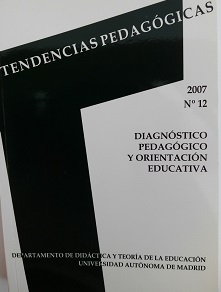Keywords:
Models of pedagogical diagnosis, Basic learning diagnosis, Criteria diagnosis.Abstract
This article discusses the issue of diagnostic models applied to the pedagogical field. We investigate the capabilities and limitations of quantitative or psychometric. qualitative and criteria methods from a critical perspective, and we favour complementarily or the choice of a method as a function of the nature of the problem. We conclude that criteria methods are the best suited for the problem of the diagnosis of instrumental learning in primary school and its problems, as a foundation for the adaptation of the planning of general or corrective, remedial or refresher education or curricular adaptations to the individual or group requirements; basic conditions of personalized education. We support our conclusion by describing the criteria diagnostic model we have developed and tested over a long period of time, and we include data on its characteristics, results and statistical controls that demonstrate its validity.Downloads
References
Anguera, Mª T. (1985). Metodología de la observación en las Ciencias Humanas. Madrid: Cátedra.
AAVV (1993). El Nivel de los Aprendizajes Instrumentales al Terminar la Escuela Primaria Española (11/12 años) y sus Implicaciones Pedagógicas. Tendencias Pedagógicas (0), Monográfico dedicado a las conclusiones del trabajo dirigido por el Dr. García Yagüe con la subvención del CIDE. Edita el Departamento de Didáctica y Teoría de la Educación (U.A.M.).
AAVV (1994). Los aprendizajes instrumentales en la Educación Primaria. Madrid. Escuela Española.
Camina Durántez, A. (1996). La lectura en los programas de la enseñanza básica española. Madrid: Departamento de Didáctica y Teoría de la Educación
(U.A.M.).
Díaz Alcaraz, F. y García García, J. J. (2004). Evaluación criterial del área de Matemáticas. Barcelona: CISSPRAXIS.
García Yagüe, J. y otros (1987). Diagnóstico Pedagógico y Técnicas de la Orientación. Madrid: UNED.
García Yagüe, J. (1986). El niño bien dotado y sus problemas. Madrid: CEPE.
Glaser, R. (1963). Instructional Technology and the Measurement of Learnig Outcomes: Some Questions. American Psycologist (18), 519-21.
Hively, W. (1974). Introduction to Domain-Referenced Testing. Educational Technology (14), 5-10.
Kelly, E. L. (1967). Assesment of human characteristics. Wadsworth Publising Company, Inc.
Huberman, A. M. y Miles, M.B. (1983). “Drawing valid meaning from qualitative data: Some techniques of data reductiom and display”. Quality & Quantity, 17,
-339.
Osburn, H. G. (1968). “Item Sampling for Achievement Testing”. Educational and Psychological Measurement, 28, 95-14.
Pophan, W. J. (1983). Evaluación basada en criterios. Madrid: Magisterio Español.
Reichardt, Ch. y Cook, T. D. (1982). “Beyond qualitative versus quantitative methods”. En T. D. Cook y Ch. S. Reichardt (Eds.), Métodos cualitativos y cuantitativos en investigación evaluativa. Madrid: Morata.
Stake, R. E. (2006): Evaluación comprensiva y evaluación basada en estándares. Barcelona GRAÓ.
Taylor, S. J. y Bogdan, R. (1992). Introducción a los métodos cualitativos de investigación. Barcelona: Paidós.
